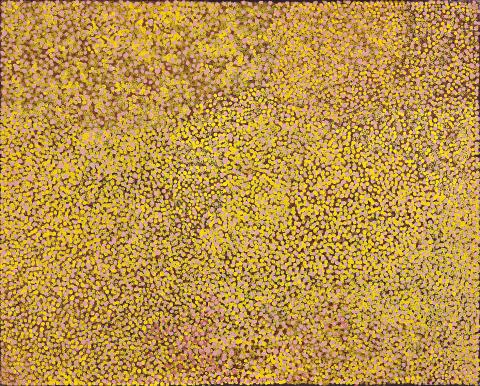UNTITLED, 1992
EMILY KAME KNGWARREYE
synthetic polymer paint on canvas
122.0 x 151.5 cm
bears inscription verso: artist’s name and Delmore Gallery cat. 92A08
Commissioned by Delmore Gallery, via Alice Springs
Gene and Brian Sherman collection, Sydney
Kame - Summer Awelye I, 1991, private collection, illus. in Isaacs, J., et al, Emily Kame Kngwarreye Paintings, Craftsman House, Sydney, 1998, pp. 70 – 71, pl. 21
Kame - Summer Awelye II, 1992 in the collection of the National Gallery of Victoria illus. in Isaacs, J., et al, Emily Kame Kngwarreye Paintings, Craftsman House, Sydney, 1998, pp. 86 – 87, pl. 23
This bright and striking early painting by Emily Kngwarreye conveys the drama and fertility of the desert landscape nurtured by the summer rains. Painted in the summer wet of 1991-1992, Untitled, 1992 is one of a series of paintings undertaken that season which celebrate the life-giving forces of nature, and the metaphorical equivalents in spiritual and human terms – recurring themes throughout the artist's body of work.
Significantly, Untitled, 1992 was created at a time when Kngwarreye’s painting was itself undergoing a process of transformation, with the artist abandoning the background tracery of the underlying yam roots, a consistent compositional device in her earlier paintings and transitioning instead into fields of pure dots. This was also a time when Kngwarreye experimented with colour and broadened her palette beyond traditional colours and their derivatives, to incorporate brighter hues such as blues, reds, greens, and in this case, vivid yellows and pinks. Kngwarreye suggests not only a sense of delight in the colours of the landscape; rather, now colour itself becomes both the impetus for – and subject of – such paintings.
Emily's painting career began in the late 1980s, and in the years until her death in 1996, she produced a body of work which radically altered the way in which we see and understand modern Aboriginal art. For most of her life she had little contact with the outside world, and thus her painting is homage to the country she knew intimately. While much has been made of the way in which we might view her work in parallel with modern, non-indigenous abstraction, we must first recognize her achievement as a truly inventive and original contribution to Aboriginal art.
CRISPIN GUTTERIDGE
